Have you ever seen an azalea blooming in August? It is a rare sight, indeed!
Plumleaf Azalea (Rhododendron prunifolium) is the latest-blooming of all North American azaleas. It starts blooming in late July or August, months after other azaleas have finished, and it has been reported still blooming in October!
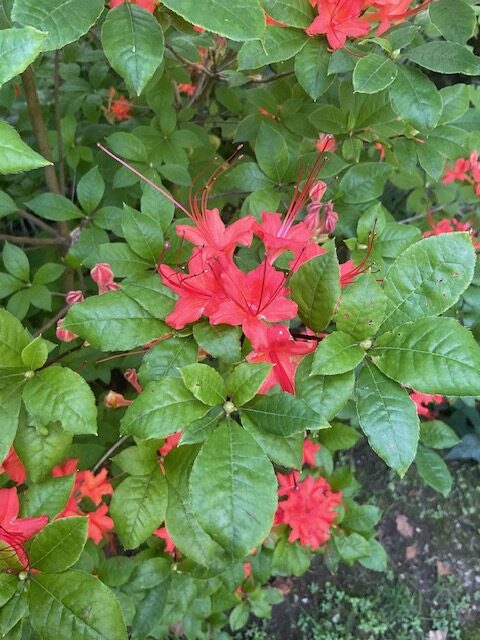
It is also the rarest of North American azaleas, native to only two states in the US. In the wild, a few small populations grow in forested sandy ravines along streams that drain into the Chattahoochee River, on the border between Georgia and Alabama. Sadly, even those few existing wild populations are threatened by development and careless logging practices, so the only native habitat of this amazing shrub is rapidly disappearing. Rhododendron prunifolium is under consideration for Endangered Species classification, but is not yet on the official list.
Plumleaf Azalea is strikingly beautiful. Its flowers are a deep red-orange with extra-long stamens that curl outward like exaggerated false eyelashes. The flowers are not particularly fragrant, but bees do visit them.
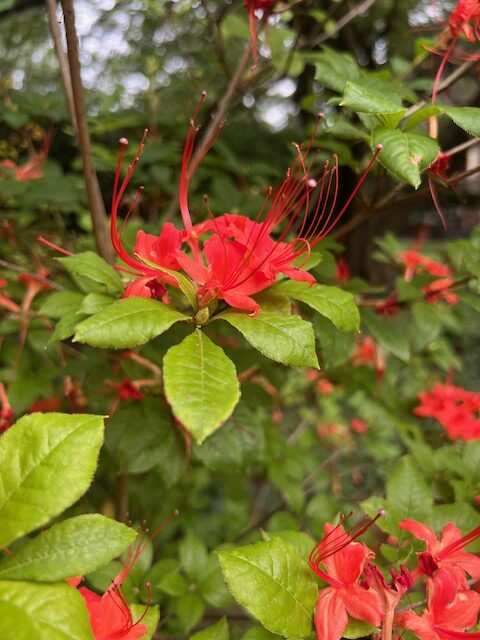
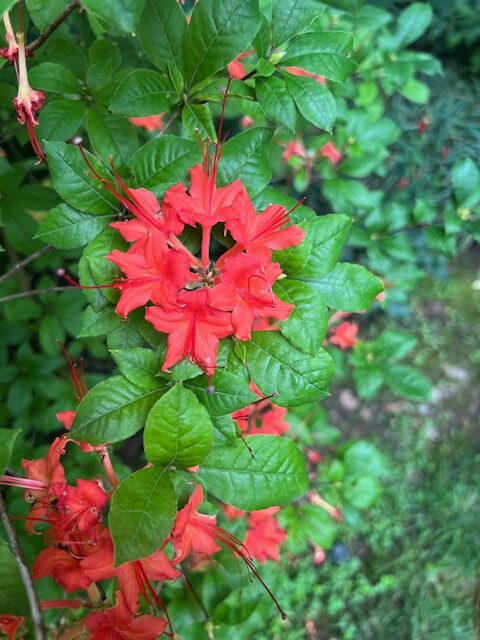
Despite its very limited native range, the shrub does very well in gardens throughout the Eastern US in Zones 5 to 7. It prefers rich, acidic soil, even moisture, and dappled sun. It has a rounded, fairly compact shape, and will reach 5 to 8 feet tall and 3 to 4 feet wide. It is an absolute show-stopper in a shady garden when nothing else is in flower.
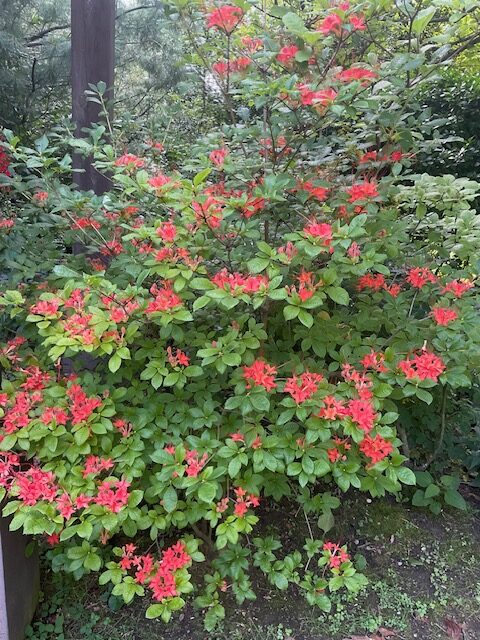
A plant as rare as Plumleaf Azalea poses a challenging question for ecology-minded gardeners. If it is native only to a limited area in Alabama and Georgia, should we be planting it in Northeastern gardens? There are several considerations:
We know that plants introduced into areas where they are not native can become invasive and cause ecological harm. (See our blog posts on very aggressive invasive plants introduced from other continents: Nip ‘Em in the Bud!, Evil Ivy Over Everything, and Boo!) While there are some native US plants that have become a nuisance when introduced outside their native range to other parts of the US, the danger is far less than with plants introduced from other continents. Plumleaf Azalea does not spread itself by the roots, and is not easily spread by seed, so it is not likely to move into areas where it is not intentionally planted.
But we also know that the value of any given plant to an ecosystem is greatest within its native range because it will have co-evolved with the other plants and animals in that ecosystem. A Colorado Blue Spruce, for example, supports insects native to the Rocky Mountains, but is of little use to most insects in the Mid-Atlantic region. Similarly, we can imagine that insects native to the Northeast may have no use for a plant from Alabama, though insects that evolved along the Chattahoochee River may depend upon that plant for survival. It is not known whether Plumleaf Azalea is a host plant for insects outside its native range, or whether it is useful to pollinators in the Northeast, but we do know that plants native to the Northeast are more valuable to local insects.
For these reasons, the best ecological choice is to plant species native to your specific region. But what if a plant is endangered in its own native region?
Michael S. Dosmann, writing for the Arnold Arboretum at Harvard University in 2022, noted that shortly after the founding of the Center for Plant Conservation in 1984, the Arnold Arboretum began collecting seed from disappearing populations of Plumleaf Azalea in three counties in Georgia. The goal was to prevent the extinction of the species. As of last year, the Arboretum was growing 34 Plumleaf Azalea shrubs – in Massachusetts. He said “preserving wild populations remains the highest priority, but it is important to have a back-up…”. He also observed that Plumleaf Azalea looks great in the garden, and for endangered species, “being charismatic and attracting attention is a gateway to its security (just look at the giant panda)!” Does planting Plumleaf Azalea in our gardens provide additional “back-up” for conservation of an endangered species? Maybe…

With that justification, anyway, growing a beautiful rare azalea that flowers in August (!) is practically a public service!!

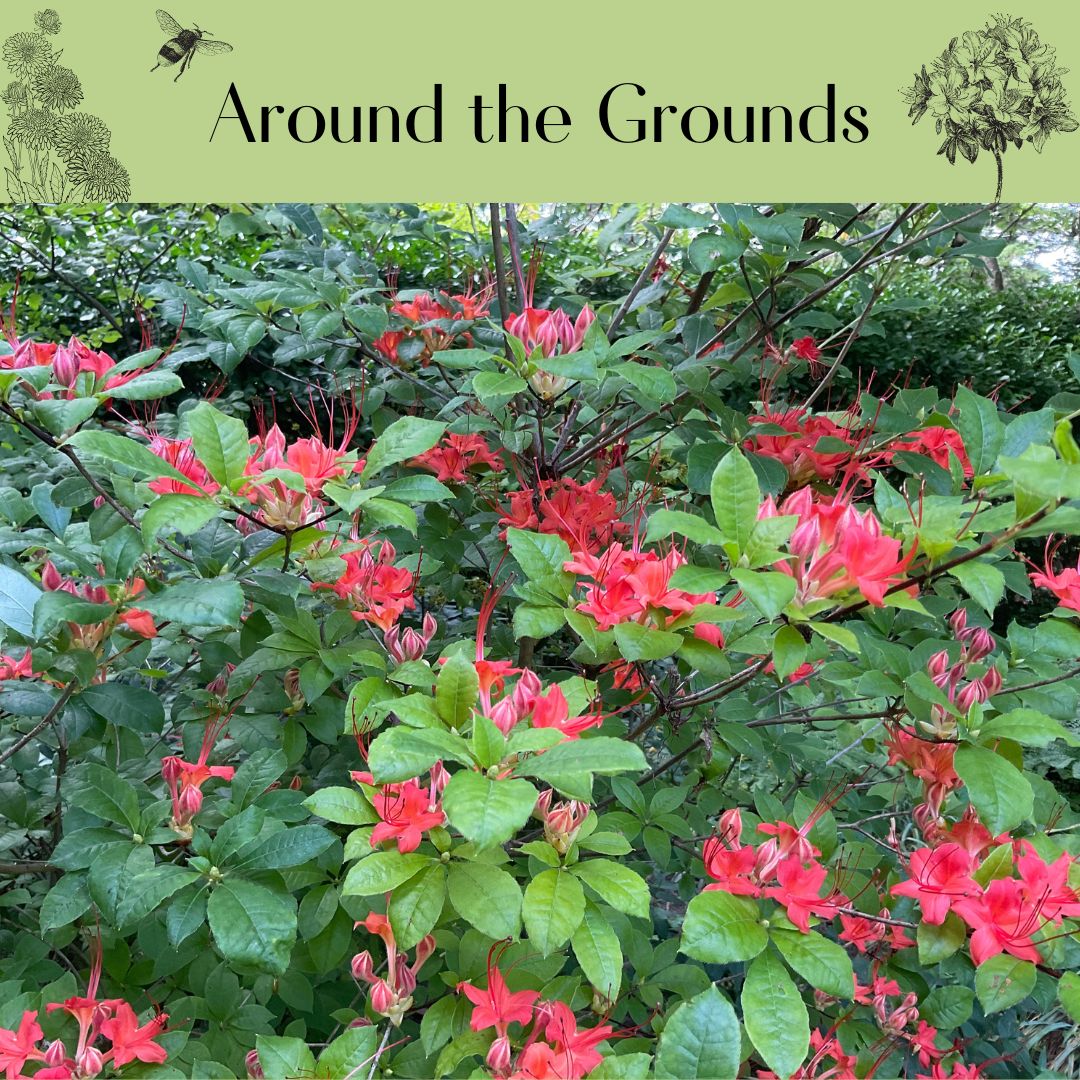
Very well written, researched, and reasoned. Thanks for a thought-provoking article on an interesting topic: whether or not to introduce Northeastern native plants to regions outside their ecosystems. Thank you!
Thanks, Brooke. Especially considering climate change, I often wonder whether expanding our definition of “native” to include a somewhat broader area is ok. I’m sure it’s always better than planting non-native species, though.
Loved your rather nuanced conversation about locally native plants, looking at the individual plants’ characteristics. Another thought … how does global warming and its effects on what is locally native fit in here?
I think about that often, Lynn. Doug Tallamy once told me that he doubts that “forced migration” of plant species to historically cooler zones (planting trees native to Virginia and the Carolinas in southern NY, for example) is as beneficial ecologically as planting truly indigenous species. But we have already seen insects expanding their ranges as climate warms (usually the undesirable ones!) No doubt Doug is right and locally indigenous species have the greatest value, but I’m willing to plant species native to adjacent eco-regions when they are great garden plants. Still a much better choice than planting anything here that evolved on a different continent.
Professor Tallamy does make a good point, which we can’t ignore. But… i think we are in uncharted waters here, and I personally would consider that lovely plant, based on the background info on it which you gave.
On a related note, I do see insect activity (and chewed leaves) on non natives, Sedum Autumn Joy being a classic example. And annuals. Even my hummingbirds visit my cleome, tithonia, red climber, zinnia. I will continue to advocate for natives, but I do question how adaptable insects have been, esp. since they are very short lived. I’d like to see more studies done (Mt. Cuba has a few good ones for cultivars, like the Phlox paniculata). Let me know if you have any good sources on that. Thanks for listening.
Good points, Lynne. So much more to learn!
Absolutely gorgeous, thank you! And thanks also for the lesson on non-native plantings – not a simple issue!
I appreciate this thoughtful discussion on introducing a non-native plant to our area. It is beautiful, I would hate to see it disappear.
Interesting and thought provoking. Thank you!